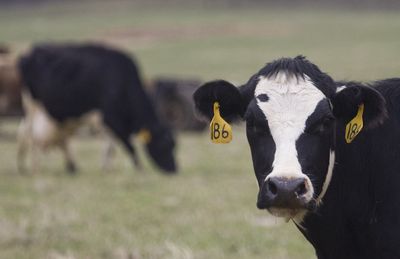Cows may have internal compass
Zoologists note north-south alignment

Birds do it, bees do it, and so, apparently, do … cows?
No, it’s not that. We’re talking about sensing the Earth’s magnetic field.
German scientists using satellite images posted online by Google Earth have observed something that has escaped the notice of farmers, herders and hunters for thousands of years – cattle grazing or at rest tend to orient their bodies in a north-south direction just like a compass needle.
Studying photographs of 8,510 cattle in 308 herds from around the world, zoologists Sabine Begall and Hynek Burda, of the University of Duisburg-Essen in Germany, and their colleagues found that two out of every three animals in the pictures were oriented in a direction roughly pointing to magnetic north.
The resolution of the images was not sufficient to tell which end of the cows was pointing north, however.
Asked if he had observed such behavior in cows, dairy farmer Rob Fletcher of Tulare, Calif., said, “Absolutely not.”
But, he added, “I don’t spend a lot of time worrying about stuff like that.”
Similar results were found in field studies of 2,974 red and roe deer in the Czech Republic, the researchers reported today in the Proceedings of the National Academy of Sciences. The researchers had been studying magnetism in smaller animals and were looking for a way to extend their work to larger species.
Cows are known to align their bodies facing uphill, facing into a strong wind to minimize heat loss or broadside to the sun on cold mornings to absorb heat. But the fact that the pictures were taken at many locations, at different times of day and in generally calm weather minimized the influence of environmental factors, the researchers said.
Researchers have long known that certain bacteria, birds, fish, whales and even rodents have minute organs in their brains containing particles of magnetite that can act like a compass. But the new results are the first hint that larger land-based mammals also might have such organs, said biologist Kenneth Lohmann, of the University of North Carolina, who was not involved in the research.
The findings are “very interesting and not at all implausible,” said geobiologist Joseph Kirschvink at California Institute of Technology, who also was not involved in the research. “We have to remember that whales are descended from a common ancestor of (cows), so this is not a surprise given what we know about whales.”
Kirschvink added, “This is an incredibly neat use of Google Earth. This is a study we would not have dreamed about doing five years ago.”
Bats, birds, bees and whales all use magnetic senses to help navigate during their travels. Kirschvink recently reported, for example, that if a pulsing magnetic field is applied to bats perpendicular to the Earth’s magnetic field, the animals will change the direction of their flight by 90 degrees in response.
What the benefit could be for cows, however, remains a mystery. It might help them find their way home, or perhaps it is a vestigial sense that is no longer used for any purpose.
Furthermore, the authors said, no one has examined cows or deer to determine whether their brains contain magnetic particles.
Experts conceded that the research almost certainly has no practical applications.